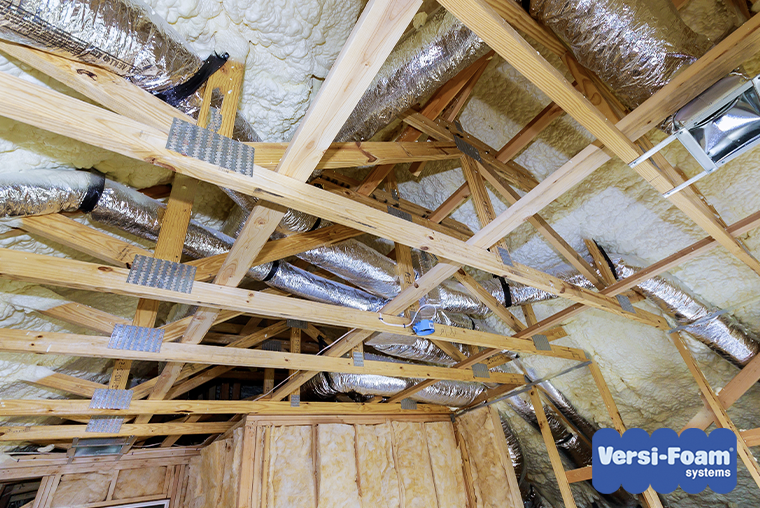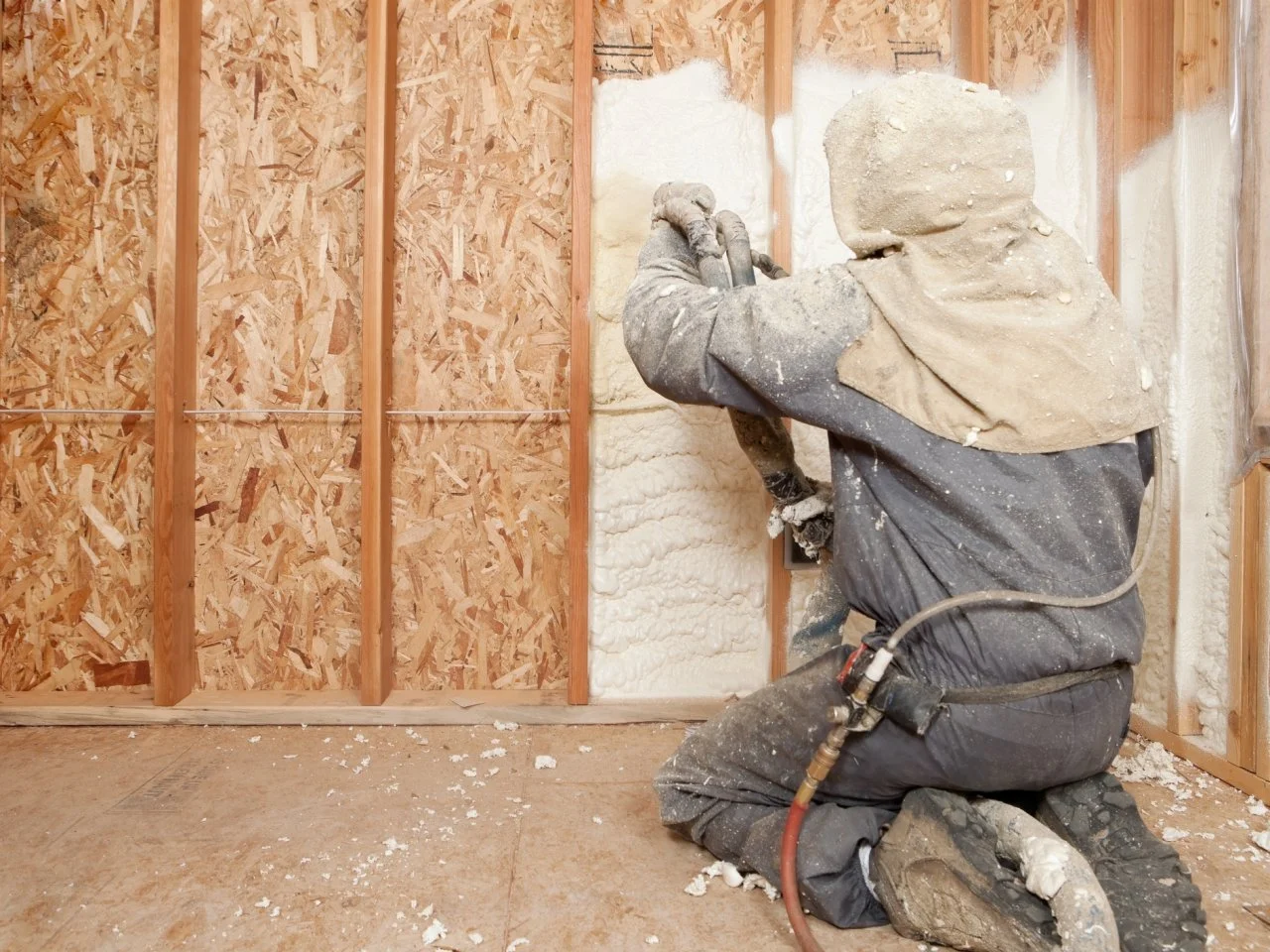Just How Spray Foam Can Enhance Power Performance in Any Kind Of Building
Spray foam insulation has emerged as a crucial remedy for enhancing energy efficiency across various structure kinds. By developing an impermeable seal that decreases air leak, it properly controls interior environments while substantially decreasing heating & cooling prices. Its outstanding R-value and moisture-resistant residential or commercial properties add to long-lasting energy savings and improved structure durability. As residential or commercial property proprietors progressively look for lasting solutions, the ramifications of spray foam insulation extend past mere energy savings. The full extent of its benefits, nonetheless, warrants a closer exam of exactly how it can change power administration techniques in both industrial and property settings.
Understanding Spray Foam Insulation
Spray foam insulation is significantly acknowledged for its remarkable thermal performance and convenience in different applications. Composed largely of polyurethane, this insulation material is used as a liquid that expands upon get in touch with, filling up gaps and creating a seamless obstacle. This one-of-a-kind residential or commercial property allows spray foam to adhere to irregular surfaces, making it a suitable choice for both domestic and commercial frameworks.

Application of spray foam insulation is typically done by qualified specialists utilizing specialized devices, ensuring ideal efficiency and security - Spray Foam. The healing process is rapid, permitting for fast installation and very little disruption. Consequently, spray foam insulation is increasingly being used in brand-new building and retrofitting tasks because of its ability to boost structural honesty while enhancing overall energy effectiveness in buildings
Advantages of Energy Performance
Energy effectiveness plays an essential duty in lowering functional costs and reducing environmental impact throughout different markets. By optimizing power use, property owners and organizations can accomplish significant cost savings on energy expenses, which straight enhances economic performance. Reliable energy usage means much less dependence on fossil fuels, therefore contributing to a decrease in greenhouse gas emissions and advertising a more sustainable environment.
Additionally, energy-efficient structures frequently experience raised residential or commercial property worths. As energy costs climb and sustainability becomes a top priority for consumers, residential or commercial properties with improved power efficiency attributes are much more eye-catching on the market. This fad motivates financial investment in energy-saving modern technologies, which can even more drive advancement and financial development.
In addition to environmental and economic advantages, power performance can also improve the overall convenience and wellness of indoor areas. Appropriate insulation and efficient heating & cooling systems assist maintain consistent temperatures, reducing drafts and humidity degrees, which consequently can result in better indoor air quality.
Ultimately, the benefits of power efficiency extend past prompt cost savings, promoting a resilient economy, promoting ecological stewardship, and boosting the top quality of life for occupants in any kind of structure.
How Spray Foam Functions
Commonly used as a liquid, spray foam expands quickly upon contact with surface areas, forming a solid obstacle that efficiently seals spaces and cracks. This special residential or commercial property is because of its chemical make-up, primarily being composed of isocyanates and polyols, which respond when blended to produce a foam that loads spaces and adheres to different materials, including steel, concrete, and timber.
As soon as applied, the foam broadens to a number of times its original quantity, making sure a limited seal that prevents air leak. This process dramatically reduces thermal linking, which happens when warm transfers with products, resulting in energy loss. The foam's high R-value, an action of thermal resistance, adds to improved insulation by minimizing heat transfer between the inside and outside environments.
Additionally, spray foam is resistant to moisture and parasites, even more enhancing its effectiveness in preserving energy efficiency. Its application can be tailored to various locations, consisting of attics, walls, and crawl areas, enhancing insulation throughout a building. Spray Foam. In general, the innovative style and application technique of spray foam make it an effective remedy for improving energy effectiveness in any kind of structure, leading to reduced power expenses and a much more sustainable developed setting

Applications in Various Buildings
Countless applications of spray foam insulation can be found throughout various building types, boosting energy performance and comfort. In household homes, spray foam is frequently made use of in attic rooms and walls to produce a smooth barrier versus air leakages, dramatically reducing home heating and cooling needs. This application is specifically valuable in older homes, where standard insulation might be inadequate.
In business buildings, spray foam insulation is put on roofing systems and exterior walls, which assists to improve thermal efficiency and protect versus moisture invasion. Its lightweight nature makes it an ideal selection for retrofitting existing structures without adding substantial weight. Additionally, spray foam can be utilized in industrial settings to shield pipelines and storage containers, preserving temperature control for sensitive materials.
Institutional structures, such as colleges and healthcare facilities, advantage from spray foam insulation by ensuring a consistent indoor climate that supports resident comfort and health. The versatility of spray foam allows it to adapt to various building sizes and shapes, making it a recommended choice for engineers and contractors seeking efficient insulation remedies. In general, spray foam insulation acts as a vital part in accomplishing energy-efficient buildings across all industries.
Long-Term Cost Savings
Spray foam insulation offers considerable long-lasting price financial savings for structure proprietors and owners by lowering energy consumption and reducing energy costs. By giving a premium air seal, spray foam lessens the seepage of outside air, therefore enhancing the thermal performance of a building. This leads to a lot more efficient home heating and cooling procedures, which can cause substantial decreases in power costs in time.
Along with instant financial savings on energy expenses, the durability and longevity of spray foam insulation add to its monetary benefits. Unlike standard insulation materials, which might reference droop, clear up, address or deteriorate, spray foam keeps its effectiveness for years, reducing the demand for constant replacements or repairs. This durability translates to reduce maintenance expenses and less interruption for owners.
Furthermore, structures outfitted with spray foam insulation typically appreciate an increase in property value, making them much more attractive to possible customers or renters. As energy effectiveness comes to be significantly prioritized, homes with reliable insulation remedies stand out out there. Eventually, the assimilation of spray foam insulation not just enhances comfort but also represents a tactical investment that generates considerable economic advantages over the long-term.
Verdict
Finally, spray foam insulation serves as an essential part in enhancing power performance across diverse structure kinds. Its capacity to develop a seamless barrier against air leak, combined with high R-values and moisture-resistant properties, significantly decreases power usage and linked expenses. The application of spray foam not only adds to constant indoor temperatures yet likewise increases residential or commercial property value, emphasizing its function as a prudent financial investment for both business and domestic residential or commercial properties.
Spray foam insulation has arised as a critical solution for enhancing power effectiveness across different building types. Spray Foam. As an outcome, spray foam insulation is progressively being employed in new construction and retrofitting projects due to its capability to enhance architectural integrity while enhancing overall energy performance in buildings
Generally, the innovative style and application approach of spray foam make it an effective option for boosting energy you could check here effectiveness in any kind of structure, leading to decreased power prices and a more sustainable constructed environment.
Various applications of spray foam insulation can be located across different structure kinds, enhancing power performance and convenience.In conclusion, spray foam insulation serves as an essential component in enhancing energy performance throughout varied building types.
Comments on “The Process of Using Spray Foam: What You Required to Know”